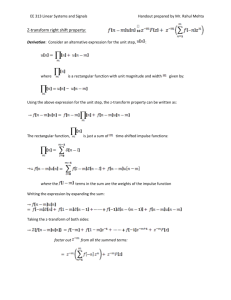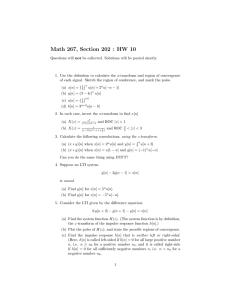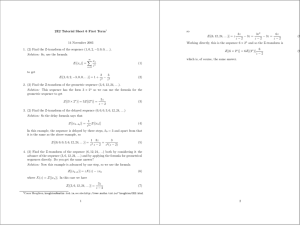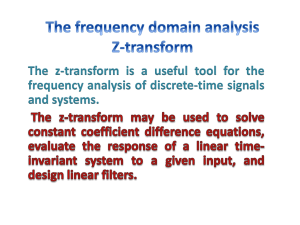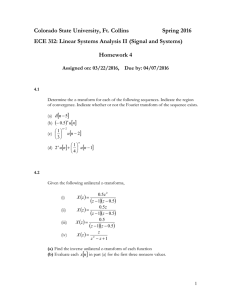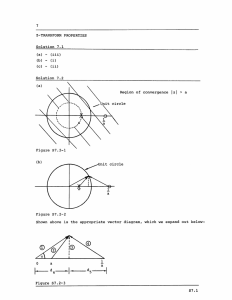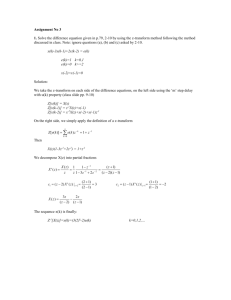Using Z-transform for solution of steady state and transient state in
advertisement
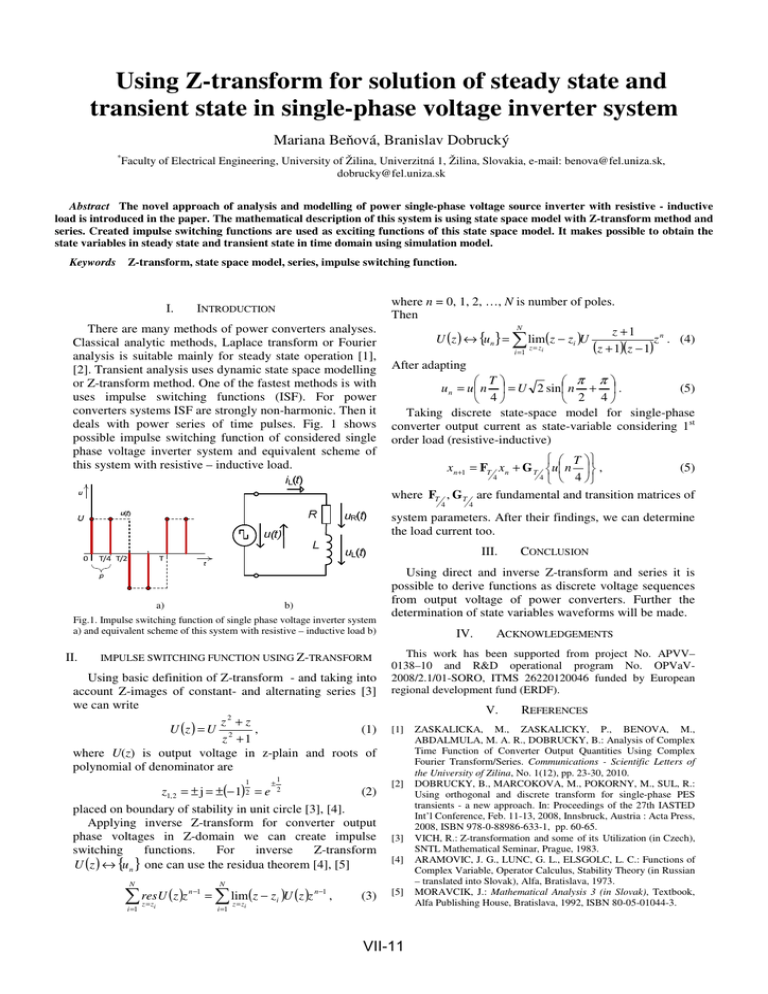
Using Z-transform for solution of steady state and
transient state in single-phase voltage inverter system
Mariana Beňová, Branislav Dobrucký
*
Faculty of Electrical Engineering, University of Žilina, Univerzitná 1, Žilina, Slovakia, e-mail: benova@fel.uniza.sk,
dobrucky@fel.uniza.sk
Abstract The novel approach of analysis and modelling of power single-phase voltage source inverter with resistive - inductive
load is introduced in the paper. The mathematical description of this system is using state space model with Z-transform method and
series. Created impulse switching functions are used as exciting functions of this state space model. It makes possible to obtain the
state variables in steady state and transient state in time domain using simulation model.
Keywords
Z-transform, state space model, series, impulse switching function.
I.
INTRODUCTION
There are many methods of power converters analyses.
Classical analytic methods, Laplace transform or Fourier
analysis is suitable mainly for steady state operation [1],
[2]. Transient analysis uses dynamic state space modelling
or Z-transform method. One of the fastest methods is with
uses impulse switching functions (ISF). For power
converters systems ISF are strongly non-harmonic. Then it
deals with power series of time pulses. Fig. 1 shows
possible impulse switching function of considered single
phase voltage inverter system and equivalent scheme of
this system with resistive – inductive load.
where n = 0, 1, 2, …, N is number of poles.
Then
N
z +1
U (z ) ↔ {un } = lim(z − zi )U
z n . (4)
z = zi
(
)(
)
z
z
+
1
−
1
i =1
After adapting
T
π π
u n = u n = U 2 sin n + .
(5)
4
2 4
Taking discrete state-space model for single-phase
converter output current as state-variable considering 1st
order load (resistive-inductive)
∑
T
(5)
x n+1 = FT x n + G T u n ,
4
4
4
where FT , G T are fundamental and transition matrices of
4
4
system parameters. After their findings, we can determine
the load current too.
III.
a)
b)
Fig.1. Impulse switching function of single phase voltage inverter system
a) and equivalent scheme of this system with resistive – inductive load b)
II.
IMPULSE SWITCHING FUNCTION USING Z-TRANSFORM
Using basic definition of Z-transform - and taking into
account Z-images of constant- and alternating series [3]
we can write
z2 + z
U (z ) = U 2
,
(1)
z +1
where U(z) is output voltage in z-plain and roots of
polynomial of denominator are
1
z1, 2 = ± j = ±(− 1) 2 = e
±
1
2
(2)
placed on boundary of stability in unit circle [3], [4].
Applying inverse Z-transform for converter output
phase voltages in Z-domain we can create impulse
switching
functions.
For
inverse
Z-transform
U (z ) ↔ {u n } one can use the residua theorem [4], [5]
N
∑
i =1
res U (z )z n −1 =
z = zi
N
∑ lim(z − z )U (z )z
i =1
z = zi
i
n −1
,
(3)
CONCLUSION
Using direct and inverse Z-transform and series it is
possible to derive functions as discrete voltage sequences
from output voltage of power converters. Further the
determination of state variables waveforms will be made.
IV.
ACKNOWLEDGEMENTS
This work has been supported from project No. APVV–
0138–10 and R&D operational program No. OPVaV2008/2.1/01-SORO, ITMS 26220120046 funded by European
regional development fund (ERDF).
V.
[1]
[2]
[3]
[4]
[5]
VII-11
REFERENCES
ZASKALICKA, M., ZASKALICKY, P., BENOVA, M.,
ABDALMULA, M. A. R., DOBRUCKY, B.: Analysis of Complex
Time Function of Converter Output Quantities Using Complex
Fourier Transform/Series. Communications - Scientific Letters of
the University of Zilina, No. 1(12), pp. 23-30, 2010.
DOBRUCKY, B., MARCOKOVA, M., POKORNY, M., SUL, R.:
Using orthogonal and discrete transform for single-phase PES
transients - a new approach. In: Proceedings of the 27th IASTED
Int’l Conference, Feb. 11-13, 2008, Innsbruck, Austria : Acta Press,
2008, ISBN 978-0-88986-633-1, pp. 60-65.
VICH, R.: Z-transformation and some of its Utilization (in Czech),
SNTL Mathematical Seminar, Prague, 1983.
ARAMOVIC, J. G., LUNC, G. L., ELSGOLC, L. C.: Functions of
Complex Variable, Operator Calculus, Stability Theory (in Russian
– translated into Slovak), Alfa, Bratislava, 1973.
MORAVCIK, J.: Mathematical Analysis 3 (in Slovak), Textbook,
Alfa Publishing House, Bratislava, 1992, ISBN 80-05-01044-3.
